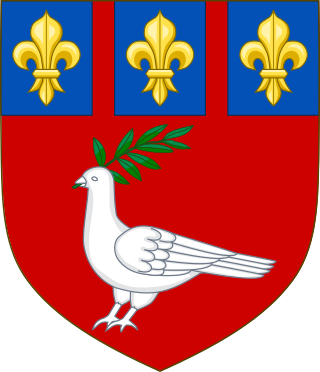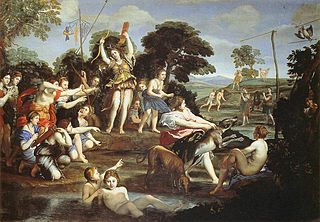
Pope Clement VIII, born Ippolito Aldobrandini, was head of the Catholic Church and ruler of the Papal States from 2 February 1592 to his death, in March 1605.

The House of Borghese is a princely family of Italian noble and papal background, originating as the Borghese or Borghesi in Siena, where they came to prominence in the 13th century and held offices under the commune. During the 16th century, the head of the family, Marcantonio, moved to Rome, where they rose in power and wealth following the election of his son Camillo as Pope Paul V in 1605. They were one of the leading families of the Black Nobility and maintain close ties to the Vatican.

Girolamo Rainaldi was an Italian architect who worked mainly in a conservative Mannerist style, often with collaborating architects. He was a successful competitor of Bernini. His son, Carlo Rainaldi, became an even more notable, more fully Baroque architect.

The House of Aldobrandini is an Italian noble family originally from Florence, where in the Middle Ages they held the most important municipal offices. Now the Aldobrandini are resident in Rome, with close ties to the Vatican.

The House of Pamphili was one of the papal families deeply entrenched in Catholic Church, Roman and Italian politics of the 16th and 17th centuries.

The Villa Aldobrandini is a villa in Frascati, Italy. It is still owned and lived in by the Aldobrandini family, and known as Belvedere for its location overlooking the valley toward the city of Rome.

Bonifazio Bevilacqua Aldobrandini was an Italian Cardinal. He was the uncle of Pope Gregory XIV.

Pietro Aldobrandini was an Italian cardinal and patron of the arts.

The Chigi Palace is a palace and former noble residence in Rome which is the seat of the Council of Ministers and the official residence of the Prime Minister of Italy. Since 22 October 2022, the tenant of the Chigi Palace has been Prime Minister Giorgia Meloni, although she doesn't live in the building. It is located in the Piazza Colonna, next to Palazzo Montecitorio, seat of the Chamber of Deputies.

Ippolito Buzzi (1562–1634) was an Italian sculptor from Viggiù, near Varese, in northernmost Lombardy, a member of a long-established dynasty of painters, sculptors and architects from the town, who passed his mature career in Rome. His personality as a sculptor is somewhat overshadowed by the two kinds of work he is known for: restorations to ancient Roman sculptures, some of them highly improvisatory by modern standards, and sculpture contributed to architectural projects and funeral monuments, where he was one among a team of craftsmen working under the general direction of an architect, like Giacomo della Porta - in projects for Pope Clement VIII, or Flaminio Ponzio - in projects for Pope Paul V - who would provide the designs from which the work was executed, always in consultation with the patron.

Olimpia Aldobrandini was a member of the Aldobrandini family of Rome, and the sole heiress to the family fortune.

In the papal conclave held from 8 to 9 February 1621, Cardinal Alessandro Ludovisi was elected to succeed Paul V as pope. Ludovisi took the name Gregory XV. It was the shortest conclave in the seventeenth century.

Camillo Francesco Maria Pamphili was an Italian Catholic cardinal and nobleman of the Pamphili family. His name is often spelled with the final long i orthography; Pamphilj.

The Adoration of the Shepherds is a painting by the northern Italian Renaissance artist Andrea Mantegna, dated to c. 1450-1451.

The Bacchanal of the Andrians or The Andrians is an oil painting by Titian. It is signed "TICIANUS F.[aciebat]" and is dated to 1523–1526.

Pope Clement VIII created 53 cardinals in six consistories.

Giovanni Battista Agucchi was an Italian churchman, Papal diplomat and writer on art theory. He was the nephew and brother of cardinals, and might have been one himself if he had lived longer. He served as secretary to the Papal Secretary of State, then the Pope himself, on whose death Agucchi was made a titular bishop and appointed as nuncio to Venice. He was an important figure in Roman art circles when he was in the city, promoting fellow-Bolognese artists, and was close to Domenichino in particular. As an art theorist he was rediscovered in the 20th century as having first expressed many of the views better known from the writings of Gian Pietro Bellori a generation later. He was also an amateur astronomer who corresponded with Galileo.

Pietro Campori was an Italian cardinal of the Catholic Church and Bishop of Cremona. He was friends with Scipione Borghese, the nephew of Pope Paul V, and was twice a candidate for election to the papacy, in the conclaves of 1621 and 1623.

The Archery Contest of Diana and Her Nymphs is a 1616 oil-on-canvas painting by the Italian artist Domenichino. The painting is also known as Diana and her Nymphs after the Hunt,Diana Hunting, and even The Hunt of Diana. It was commissioned by Cardinal Pietro Aldobrandini, but was stolen from him by Cardinal Scipione Borghese. It is now in the Galleria Borghese in Rome, Italy.

The Altoviti are a prominent noble family of Florence, Italy. Since the medieval period they were one of the most distinguished banking and political families appointed to the highest offices of the Republic of Florence, friends and patrons of Galileo Galilei, Vasari, Raphael, and Michelangelo. They had a close personal relationship with the papacy. Through a predominant endogamous marriage policy they established alliances with dynasties of principal and papal nobility as the Medici, Cybo, Rospigliosi, Sacchetti, Corsini, and Aldobrandini.























